
Quick tips on Symphonic Choirs: Portamento
by Piotr Musia³
Note: This tutorial was made using Cubase 4 Studio and Kontakt 3
Hi. My name is Piotr Musia³ and I welcome You to my next tutorial!
EWQL Symphonic Choirs is a great instrument. Despites the fantastic Wordbuilder plugin, that makes our choirs sing phrases, we want them to sing, it has very nice sound and variety of articulations. It also has solo voices, such as soprano, alto and a boy soloist, which would be more helpfull, if they were more playable.
What might appear missing in this library is – portamento. An effect, highly requested in new orchestral and choir libraries. In real life it's produced by quick legato transitions from one note to another by a voice, or an instrument. Check for yourself – try singing C2 and then quickly change it to C3 (or an octave lower, if you are a bass:). Notice the short slide between the two. It's natural.
It's not a surprise, that most of us would give more than warm welcome to such a feature in EWQL Symphonic Choirs. Such an effect could be very musical, and could increse realism on some passages. Unfortunatelly, trying to program it into phrases with text, would take a lot of time and effort. However, one of the most popular forms in which choirs are used in film and even classical music are „oh's” and „ah's” („mm's” as well). That we can do, in a very easy way! And we can make it now, before there even is a release date for SC PLAY version. (I hope it will actually include this feature anyway)
STEP 1
TOOLS
Let's see what we need:
EWQL Symphonic Choirs NI/Kompakt version.
Kontakt 2 or above (sorry, if this dissapoints You)
SIPS 2.05 scripts by Robert Villwock.
You certainly know, where to get 1 and 2 from. For the scripts, let's visit:
http://nilsliberg.se/ksp/scripts/sips/sips.htm
They are free! Let's download and install them into your Kontakt scripts folder, which, most probably is something like this:
C:\Documents and Settings\YouUserName\My Documents\Native Instruments\Kontakt 3\presets\scripts
If you are having troubles here, refer to SIPS's User's Guide.
STEP 2
SOLO SOPRANO SETUP
Personally, I love the sound and recording of solo soprano voice in EWQLSC. It could totally use legato with portamento. Nothing easier than that (:P).
First, we need to decide which mic position to use. My opinion is, that it sounds best with Close mic, because F and S mics have more room ambience and release trails, which do not work well with synthetic portamento, produced by the script. (As you will soon hear, it's not that synthetic in effect at all)
Ok, so let's load into Kontakt Close mic of Soprano Solo voice and assign a midi channel to it. Now, first thing to do, is to click on „Script Editor” button and load SIPS scripts. Go to „Presets” and look for SIPS folder (it's probably under „User” scripts) and load SIPS Starter. This one doesn't do much, but initiates SIPS. Big Bob (author of SIPS) recommends we put it into the first script slot.
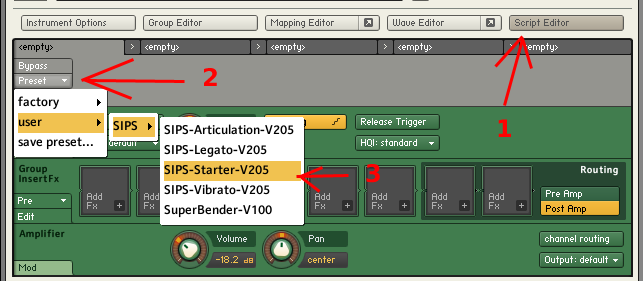
The next one to load (into the second slot) should be „SIPS – Ledato”. Once it will open, it will probably prompt you to move midi controller before it can start working. Simply, move mod wheel or any other CC on this channel, and the interface will appear.
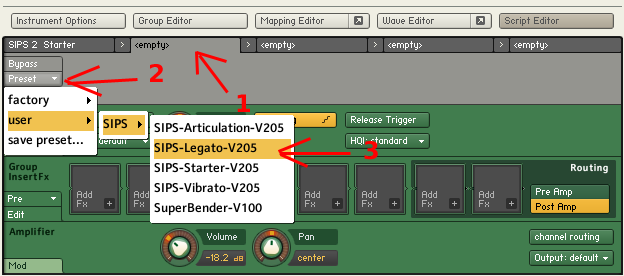
It's good to get familiar with the interface and all the functions, using reference SIPS Guide. If you want quick results, just change sript mode from Legato to Portamento.
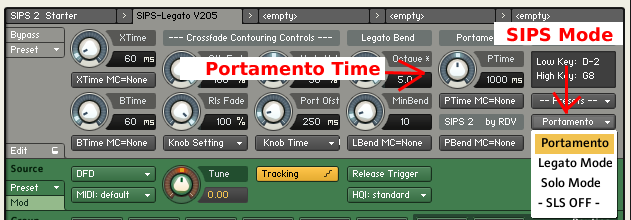
Play a couple of notes to hear the results. Sounds a bity synthy? Let's cover this with a reverb. I used SIR 1011 fed with a free impulse response sample of a real hall, downloaded from noisevault:
http://noisevault.com/nv/index.php?option=com_remository&Itemid=29
You may as well use reverb of your choice. Tweak the settings as you play.
This is basically the whole idea. Sounds good to me!
STEP 3
TIPS, TRICKS & THINGS TO KNOW
There's a couple of things to know about the script and tips to make a better use of it.
SOLO
First thing to know is that SIPS Legato script, does only do solo. You can however add one or more voices, by loading and seting up another patches in an exactly the same way, then assigning them to another midi channels. It may be a bit time consuming (and channel-hungry), but the final effect, will most probably be rewarding.
PLAYING STYLE & PORTAMENTO
If you don't know already, while recording or playing the portamento parts, to make the script work, you should take care of time between two sounds. If there's a break, the two will not be legatoed. The first note should slightly overdub the beginning of the second note. Just like on the picture below:
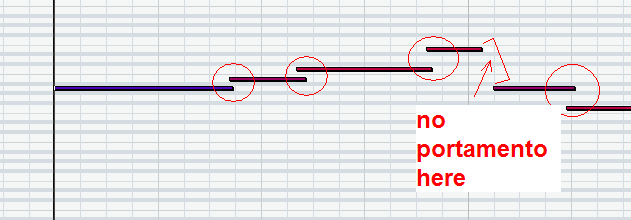
KEYSWITCHING
You should also be aware, that changing keyswitches between two sounds, that are connected, is not possible, because SIPS will not understand, that the lowest keys are not actually sounds you want it to legato to.
This generally is true, unless you turn SIPS off, before you change articulations, and then turn it on again. You CAN do it, using custom CC parameter, which can be assigned by clicking two times on: „Mode MC=None” button and selecting CC parameter you want to use. This way, to change keyswitches during a legato phrase, for example, to do a transition from „oh's” to „mm's” – simply turn SIPS off, by feeding the CC with 0, then put the keyswitch key, and feed the CC back with 127 (it's Portamento). As shown below:
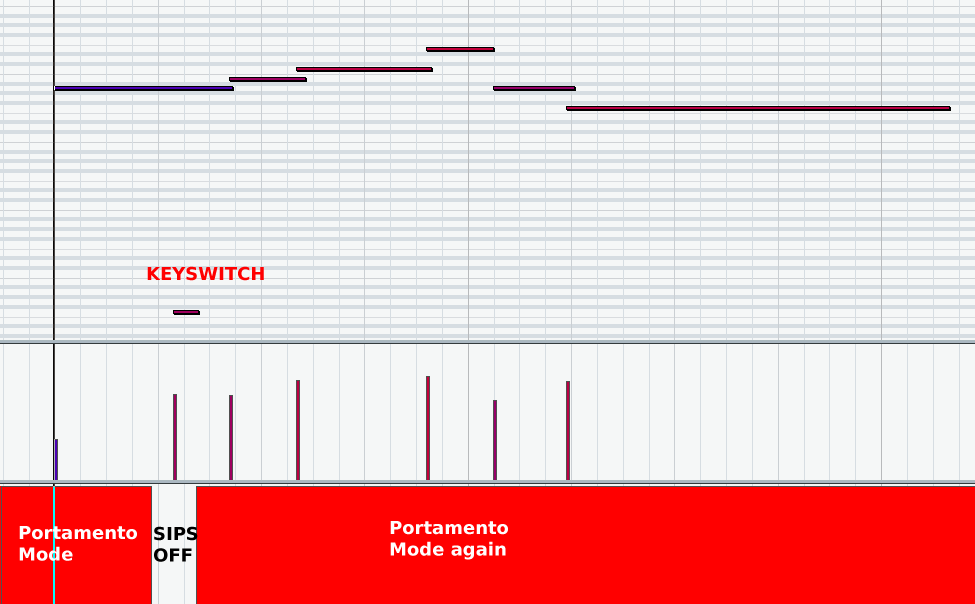
PORTAMENTO TIME
One thing, that you might want to do with this or other patches, is to automate the time of portamento effect. It's very easy to assign CC parameter to control it. Click on „PTime MC=None” button and select CC of your choice (for example ModWheel - CC1). Now, feed the CC with 0 – set up the Portamento Time knob to zero. Then, feed the CC with max value, set the knob to the highest value, you want to use. For example 1000ms. We can set minimum and maximum time this way.
Now, while you play, use the CC to control the portamento time. Short passages will sound better with low time, and high jumps, like by an octave, can use more time. Also, check for yourself by singing – a jump by and octave up will probably take you more time, than going the octave back down.
TAKE ADVANTAGE OF REAL VIBRATO
I also have one more tip for you regarding this particular patch – use vibrato articulations rather than nonvibrato. They sound more natural (overall, and with the script), especially when making transition in the very moment, when the voice is vibrating.
THAT'S IT?
Absolutely not. It's only a beginning :). This techniques can be used with more than just soprano solo. Take bass choirs for example. Take soprano choirs. VSL has it's own real portamento-capable Soprano Choirs, we can have our own „synthesized”, yet maybe even better sounding wtih EWQLSC. We can even have full choirs singing „oh” with portamento. Check for yourself. It can quickly make you inspired.
Have fun!
Piotr Musia³
